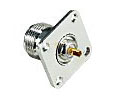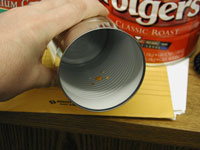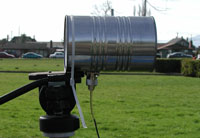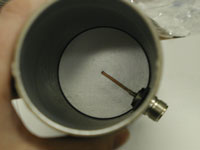Assemble the probe and mount in can
Now you'll need that bit of wire. You'll need a soldering iron or a
friend with one as well. Cut the wire so that when it is stuck in the
connector as shown, the total length of both the brass tube and wire
sticking out past the connector is 1.21". Get as close to this length as
you can.
When you've got your wire correctly sized, solder it into the connector
keeping it as straight and upright as you can. When it's cooled, bolt or
screw the assembly into your can. Put the heads of the bolts inside the
can and the nuts on the outside to minimize the obstructions in your
antenna. Your Done!
Hook up your cable, point the antenna at a friend's, and see how far
you can stretch you network. Be sure to let me know how it works.
This antenna has linear polarization. That means that how you rotate
the antenna will affect the strength of your signal. Usually, you will
want to put the connection straight down, but experiment with rotating the
can while watching the signal strength on your PC to get the best
performance.
For more information, check out these resources:
|








